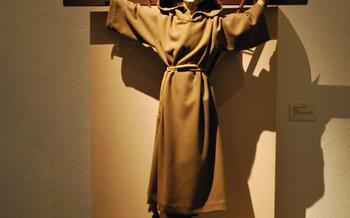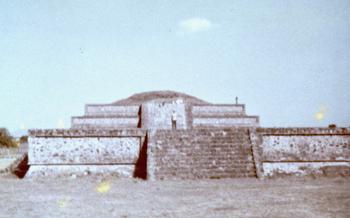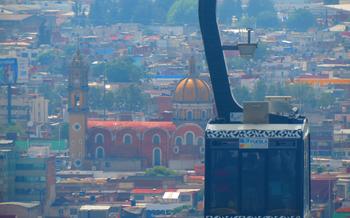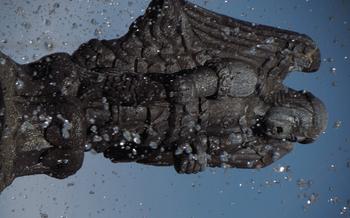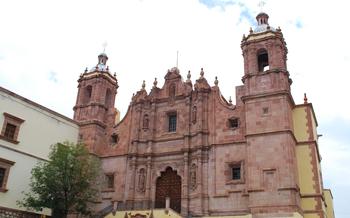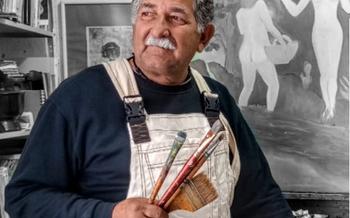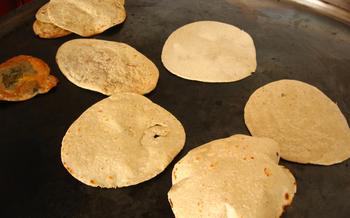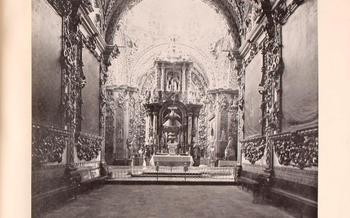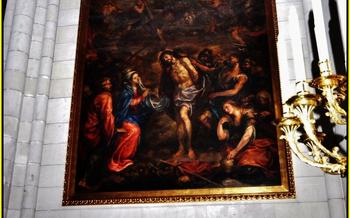
Museo Poblano de Arte Virreinal
- Museo Poblano de Arte Virreinal: A Cultural Gem
- Exploring the Collection: A Tapestry of Artistic Styles
- The Legacy of the Spanish Empire
- The Masterpieces of the Museo Poblano
- The Divine and the Human: Exploring Religious Imagery
- Voices from the Past: The Stories Behind the Artworks
- A Walk Through History: The Museum's Historical Galleries
- The Museum as a Showcase for Puebla's Cultural Identity
- Temporary Exhibitions: A Window to the Contemporary Art Scene
- Educational Programs and Workshops
- Accessibility and Inclusivity at the Museum
- Planning Your Visit: Tips for a Smooth Experience
Museo Poblano de Arte Virreinal: A Cultural Gem
A gem as a testament to the artistic legacy of Puebla. Situated in the heart of the city, this remarkable museum houses a vast collection of colonial-era art, offering visitors a journey through time and a glimpse into the region's rich cultural heritage.
Practical Information:
- Address: Calle 4 Norte No50 USD). Discounts are available for students, seniors, and children.
Exploring the Collection: A Tapestry of Artistic Styles
The Museo Poblano de Arte Virreinal boasts a diverse collection of artworks that showcase a variety of artistic styles and techniques. Among the most notable art forms represented are painting, sculpture, and textiles. The museum houses a significant collection of paintings, ranging from religious iconography to secular portraits. These works demonstrate the mastery of local and international artists, capturing the essence of the Mexican Baroque style with vibrant colors and intricate details.
The museum's collection also includes a remarkable array of sculptures. From delicate carvings in wood and ivory to imposing stone sculptures, these works showcase the exceptional craftsmanship of the period. Visitors can admire the intricate details and lifelike expressions that bring these figures to life.
The collection is further enriched by a variety of textiles, including tapestries, embroideries, and garments. These textiles provide a glimpse into the daily lives and traditions of the people of Puebla. The vibrant colors and intricate designs reflect the region's rich cultural heritage and offer a tangible connection to the past.
The Legacy of the Spanish Empire
The Museo Poblano de Arte Virreinal is a testament to the profound influence of the Spanish Empire on Mexican art and culture. During the colonial period, which lasted from the 16th to the 19th century, Spain's cultural and artistic traditions were deeply intertwined with those of Mexico. This fusion of influences is evident in the museum's collection, which features numerous artworks that reflect the Baroque and Churrigueresque styles that were popular in Spain during that time.
One of the most striking examples of Baroque architecture in the museum is the grand staircase, which features intricate carvings and decorative elements that create a sense of drama and opulence. The staircase leads to the museum's upper galleries, which house a wealth of paintings, sculptures, and other artworks that showcase the skills and artistry of Mexican craftsmen during the colonial period.
The Churrigueresque style, which is characterized by its exuberant use of ornamentation and decorative details, is also well represented in the museum's collection. This style can be seen in the elaborate altars, retables, and other religious objects that adorn the museum's chapels and galleries.
The Spanish Empire's influence on Mexican art extended beyond architecture and religious art. The museum also houses a collection of secular paintings, sculptures, and decorative arts that reflect the influence of Spanish culture on Mexican society. These artworks depict scenes from everyday life, as well as portraits of prominent figures from the colonial period.
Through its collection of artworks, the Museo Poblano de Arte Virreinal offers visitors a glimpse into the rich cultural legacy of the Spanish Empire in Mexico. The museum's collection is a testament to the enduring impact of Spain's cultural and artistic traditions on Mexican society.
The Masterpieces of the Museo Poblano
Among the treasures housed within the Museo Poblano de Arte Virreinal, several masterpieces stand out for their exceptional beauty and historical significance. One such masterpiece is the painting "La Virgen de la Soledad" by Cristóbal de Villalpando, a 17th-century master of the New Spanish Baroque style. This poignant depiction of the Virgin Mary captures her serene yet sorrowful expression as she gazes upon the crucified Christ, symbolizing the profound grief and devotion associated with the Passion.
Another highlight is the sculpture "El Cristo de la Agonía" by Manuel Tolsá, a renowned 18th-century sculptor. This life-size wooden sculpture portrays the suffering Christ on the cross with remarkable realism and emotional intensity, showcasing Tolsá's mastery of anatomical detail and dramatic composition.
Finally, the museum boasts an impressive collection of Talavera pottery, a type of majolica ceramics produced in Puebla since the 16th century. These colorful and intricately decorated plates, vases, and tiles exemplify the region's rich ceramic tradition and are considered some of the finest examples of Mexican Talavera in existence.
These masterpieces, along with countless other treasures, make the Museo Poblano de Arte Virreinal a must-visit destination for anyone interested in Mexican art and history.
The Divine and the Human: Exploring Religious Imagery
The Museo Poblano de Arte Virreinal is a treasure trove of religious art, offering visitors a profound glimpse into the spiritual beliefs and practices of Mexico's past. Through paintings, sculptures, and intricate altarpieces, the museum explores the complex relationship between humans and the divine.
Biblical scenes and the lives of saints are vividly depicted in the museum's collection, showcasing the mastery of artists in conveying religious narratives. Each artwork tells a story, inviting visitors to contemplate the divine and its influence on human existence.
The museum's religious artworks also employ a wealth of artistic techniques and symbolism to convey religious messages. From the use of gold leaf to represent heavenly light to the depiction of symbolic animals and plants, each element is carefully chosen to enhance the spiritual impact of the artwork.
Whether you're a devout believer or simply curious about the role of religion in Mexican culture, the Museo Poblano de Arte Virreinal offers a fascinating journey into the realm of the divine and the human.
Voices from the Past: The Stories Behind the Artworks
Each artwork in the Museo Poblano de Arte Virreinal holds a unique story, a glimpse into the lives of the artists who created them and the times in which they lived. These stories are waiting to be uncovered, adding depth and meaning to the museum's collection.
One poignant tale is that of the anonymous artist who crafted the sculpture of "La Virgen de los Dolores" (Our Lady of Sorrows). Carved from a single block of wood, this masterpiece captures the Virgin Mary's profound grief as she holds the body of her crucified son. Legend has it that the artist was so moved by the suffering depicted in the sculpture that he shed tears as he worked, leaving visible traces on the wood.
Another story surrounds the painting "El Martirio de San Sebastián" (The Martyrdom of Saint Sebastian) by the renowned artist José Juárez. This powerful work portrays the saint tied to a tree and pierced by arrows, his body contorted in agony. It is said that Juárez used his own blood to paint the martyr's wounds, imbuing the artwork with a visceral sense of realism and emotional intensity.
These are just a few examples of the many fascinating stories that lie hidden within the Museo Poblano's collection. As visitors explore the galleries, they are invited to delve deeper into the lives and inspirations of the artists, discovering the rich tapestry of human experience woven into the fabric of Mexican art.
A Walk Through History: The Museum's Historical Galleries
The Museo Poblano de Arte Virreinal is not just a collection of artworks; it is a journey through time, showcasing the evolution of Mexican art and culture from the colonial period to the present day. The museum's galleries are arranged chronologically, allowing visitors to trace the development of artistic styles and themes over several centuries.
Begin your journey in the early colonial period, where you'll find works that reflect the influence of the Spanish conquerors. Admire the intricate Baroque paintings and sculptures that adorn the walls, depicting religious scenes and the lives of saints. As you move through the galleries, you'll encounter works from the 18th century, characterized by the exuberant Churrigueresque style with its elaborate ornamentation and dynamic forms.
The 19th century brought significant changes to Mexican art, and the museum's collection reflects this transformation. Neoclassical and Romantic styles emerged, characterized by a return to classical forms and a focus on emotional expression. You'll find works by renowned Mexican artists such as Miguel Cabrera, José María Velasco, and Saturnino Herrán, who captured the essence of this transitional period.
The museum's final galleries showcase contemporary Mexican art, featuring works from the 20th and 21st centuries. Here, you'll encounter a diverse range of styles and mediums, from abstract paintings to conceptual installations. These works reflect the vibrant and innovative spirit of contemporary Mexican art, offering a glimpse into the future of this dynamic cultural landscape.
The Museum as a Showcase for Puebla's Cultural Identity
The Museo Pobs distinct cultural legacy. Its collection epitomizes the city's rich history, vibrant traditions, and unique artistic expressions. By showcasing artifacts that chronicle Puebla's evolution from a humble indigenous settlement to a flourishing colonial city, the museum plays a pivotal role in fostering a sense of local pride and identity.
The museum's galleries are a testament to the city's deep-rooted cultural heritage. They house an array of objects that showcase Puebla's distinctive blend of indigenous, Spanish, and mestizo influences. From intricate Talavera pottery to opulent religious paintings, each artifact tells a story of Puebla's past and its enduring impact on Mexican culture.
Beyond its collection, the museum also hosts educational programs, workshops, and exhibitions that celebrate Puebla's vibrant artistic traditions. These initiatives provide a platform for local artists to showcase their work, fostering a sense of community and encouraging cultural exchange.
By preserving and showcasing Puebla's cultural heritage, the Museo Poblano de Arte Virreinal plays a vital role in shaping the city's identity and ensuring that its rich traditions continue to thrive for generations to come.
Temporary Exhibitions: A Window to the Contemporary Art Scene
In addition to its permanent collection, the Museo Poblano de Arte Virreinal also hosts a dynamic program of temporary exhibitions that showcase the work of contemporary Mexican and international artists. These exhibitions offer a fresh perspective on the museum's collection, inviting visitors to explore new artistic styles, themes, and ideas.
Recent exhibitions have featured a diverse range of artists, from emerging talents to established masters, working in a variety of media, including painting, sculpture, photography, and installation art. The themes explored in these exhibitions have ranged from the traditional to the avant-garde, reflecting the diversity and vitality of the contemporary Mexican art scene.
Temporary exhibitions at the Museo Poblano de Arte Virreinal are an excellent way to experience the latest trends in Mexican art and culture. They offer a unique opportunity to see the work of talented artists who are pushing the boundaries of artistic expression and challenging conventional notions of art.
Visitors are encouraged to check the museum's website or social media pages for information about upcoming exhibitions. The museum also offers guided tours of its temporary exhibitions, providing visitors with insights into the artists' creative processes and the themes explored in their work.
Educational Programs and Workshops
The Museo Poblano de Arte Virreinal offers a variety of educational programs and workshops designed to engage visitors of all ages with its collection and promote a deeper understanding of Mexican art. These programs include guided tours that provide insights into the historical context, artistic techniques, and symbolism of the artworks. Lectures by experts in Mexican art history offer comprehensive overviews of different periods and styles, while hands-on workshops allow visitors to experience the creative process firsthand by creating their own artworks inspired by the museum's collection. These educational initiatives not only enhance the visitor experience but also contribute to the museum's mission of preserving and disseminating Mexico's cultural heritage.
Accessibility and Inclusivity at the Museum
The Museo Poblano de Arte Virreinal is committed to making its collection and exhibitions accessible and inclusive to visitors of all abilities. The museum features a range of accessibility features to ensure that everyone can enjoy and appreciate its cultural treasures.
Wheelchair ramps and elevators are available throughout the museum, providing easy access to all floors and galleries. Accessible restrooms are also available for the convenience of visitors with disabilities.
The museum offers programs and services designed to make the museum accessible to all. Guided tours for visitors with disabilities are available upon request, providing detailed descriptions and insights into the artworks and their historical context.
For visitors who are deaf or hard of hearing, the museum offers sign language interpretation services for guided tours. These services must be requested in advance to ensure availability.
The museum also provides educational materials in a variety of formats, including large print and audio guides, to accommodate visitors with different learning styles and needs.
By creating an inclusive environment, the Museo Poblano de Arte Virreinal ensures that everyone can engage with and appreciate the rich cultural heritage showcased within its walls.
Planning Your Visit: Tips for a Smooth Experience
To make the most of your visit to the Museo Poblano de Arte Virreinal, a little planning can go a long way. Here are some insider tips to ensure a smooth and enjoyable experience:
-
Timing is Everything: Aim to visit the museum during the week or early on weekends to avoid crowds. The museum is typically less crowded in the morning, allowing you to explore the collection at a leisurely pace.
-
Parking Made Easy: Street parking can be limited in the area, so consider using the museum's parking lot for convenience. It is located just a short walk from the museum's entrance.
-
Enhance Your Experience: Take advantage of the museum's guided tours to delve deeper into the history and significance of the artworks. These tours are offered in Spanish and English and provide a wealth of information to enrich your visit.
-
Combine and Conquer: The museum is situated in the heart of Puebla's historic center, surrounded by other cultural attractions. Consider combining your visit with a stroll through the city's colonial streets, exploring nearby landmarks like the Catedral de Puebla, or visiting other museums in the area.
